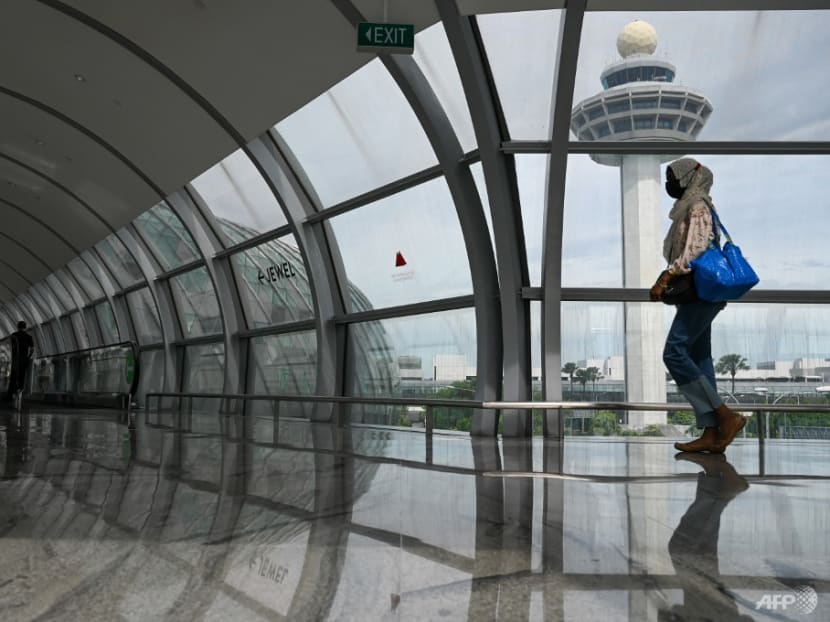Work on Changi Airport’s Terminal 5 to resume after two-year hiatus: Iswaran
Construction is expected to start in about two to three years, for the terminal to be ready to meet anticipated demand around the mid-2030s.

A woman walks across a link bridge to a terminal at Singapore's Changi Airport on Sep 8, 2021. (File photo: AFP/Roslan Rahman)
SINGAPORE: Changi Airport’s Terminal 5 (T5) project will resume after being put on pause for two years due to “pandemic-fuelled uncertainties”, announced Transport Minister S Iswaran on Tuesday (May 17).
“Given the current and projected recovery in air travel demand, we have a renewed impetus to secure our infrastructural capacity for growth,” he said during the opening address of the Changi Aviation Summit held at the Sands Expo and Convention Centre.
“We have taken the opportunity of the two-year hiatus to comprehensively review the T5 design to make it more modular and flexible, and enhance its resilience and sustainability. We will re-mobilise the design and engineering consultants progressively, to update and further refine the T5 design.”
Depending on the pace of recovery, Mr Iswaran said the construction of T5 is expected to commence in about two to three years, for the terminal to be “ready to meet the anticipated demand around the mid-2030s”.
The T5 project was halted two years ago in order to “first navigate the COVID-19 challenge, re-assess the trajectory of aviation growth, learn from the pandemic experience, and review T5’s design to meet the needs of post-pandemic travel”, the minister added.
EXPANDING PROGRAMMES, ENHANCING TECHNOLOGICAL CAPABILITIES
At the two-day summit organised by the Ministry of Transport and the Civil Aviation Authority of Singapore (CAAS), Mr Iswaran covered three aspects of aviation recovery: Capabilities, capacity and climate.
To support aviation recovery and growth, it is “essential that we continue to grow our aviation workforce, and equip them with the knowledge and skillsets to innovate, seize new opportunities and adapt to disruptions”, said Mr Iswaran, who is also Minister-in-Charge of Trade Relations.
For instance, Singapore should build on the International Civil Aviation Organization’s (ICAO) “No Country Left Behind” and “Next Generation of Aviation Professionals” initiatives, and “strengthen our focus on fundamentals such as aviation safety, as well as urgent long-term priorities like sustainability”, he said.
As such, the Singapore-ICAO Developing Countries Training Programme (DCTP) will be extended for another three years. Under this latest extension, the programme will provide US$1.6 million of training assistance over three years in fellowships and scholarships.
Aviation leaders and professionals from developing ICAO Member States can apply for these fellowships and scholarships to attend “specialised aviation programmes” at CAAS' training arm Singapore Aviation Academy (SAA), said CAAS in a press release on Tuesday.
Fellowship recipients can attend training programmes ranging from aviation management to aviation safety and security management. Meanwhile, scholarship recipients will attain an SAA Diploma in Civil Aviation Management or Aviation Safety Management.
There are also programmes to help aviation professionals “distil lessons learnt from the COVID-19 pandemic”, said CAAS.
The DCTP, established in 2001, has supported the training of around 1,500 government officials from 130 countries thus far.
Mr Iswaran also shared that “enhancements to technological capabilities” should complement efforts to “augment (the) aviation talent pool”.
“In particular, we can harness technology to further streamline and harmonise our travel protocols,” he said.
“One key enabler in this regard will be the promulgation of digital health certificates and credentials, and their mutual recognition. This will enable travellers to present digitally verifiable certificates for their health status to be easily and reliably authenticated.”
In this regard, Singapore and the African Union have just established a framework for the mutual recognition of COVID-19 vaccination certificates, adding to the portfolio of digital vaccination certificates that Singapore can recognise, added Mr Iswaran.
From May 23, fully vaccinated travellers with digital certificates issued via the Africa Centres for Disease Control and Prevention’s (CDC) Trusted Travel and Trusted Vaccines platforms can upload and validate their certificates through the Immigration and Checkpoints Authority's (ICA) Vaccination Check Portal or the Singapore Arrival Card to verify their vaccination status.
Similarly, fully vaccinated travellers with digital certificates issued in Singapore can securely obtain vaccination passes on African Union's Trusted Travel and Trusted Vaccines platforms.
“It is only through global cooperation of the aviation community that we can unlock such mechanisms for the mutual recognition of digital health credentials, to enhance the travel experience and accelerate the recovery of air travel.”
Additionally, the Government will also invest in “new concepts” for air traffic management, as well as the next generation of air navigation services systems, to ensure operational capacity to manage expected growth in air traffic, said Mr Iswaran.
The International Air Transport Association (IATA) forecasts that passenger air traffic in the Asia-Pacific will grow at 4.5 per cent annually over the next 20 years, “effectively doubling volume over the next two decades”, he added.
“To accommodate this growth in air traffic safely and efficiently, Singapore is also working closely with our regional partners towards the vision of a seamless sky.”
BUILD UP CAPACITY IN ANTICIPATION OF DEMAND
Amid the reopening of borders, Mr Iswaran noted the capacity of airports to cope with the recovery of air travel.
At the “depth of the pandemic” during April and May 2020, passenger traffic at Changi Airport declined to “barely 0.5 per cent” of pre-COVID volumes, said Mr Iswaran.
But the reopening of our borders has shown “encouraging signs of recovery”, and this is only expected to strengthen.
“We are already seeing evidence of this in Singapore. Passenger traffic has more than doubled to above 40 per cent of pre-COVID levels in May, compared to just under 20 per cent in mid-March,” said Mr Iswaran.
He also highlighted a comment by Mr Willie Walsh, director-general of IATA, that overall air passenger numbers are expected to recover to pre-COVID levels by 2023 — one year earlier than previously anticipated.
“While there are good reasons to be optimistic about the future growth of air travel demand, it is incumbent that we do not forget pre-COVID capacity challenges. To reduce ground congestion and the consequential delays in the air, we must strive to build up capacity in anticipation of demand,” added Mr Iswaran.
Expansion plans put in place before the pandemic by airports would now have to be “revisited to safely, seamlessly, and sustainably support a return to pre-pandemic rates of growth in air travel”.
Related:
AVIATION COMMUNITY NEEDS “DECISIVE ACTION” ON CLIMATE CHANGE
Mr Iswaran also spoke about climate change and the need to decarbonise air travel.
Pre-COVID, aviation accounted for “more than 900 million tonnes of carbon dioxide emissions globally” or “2 per cent of global emissions”.
“If we fail to act, the sector’s emissions could more than double by 2050 from 2019 levels. This is not tenable – for the aviation sector nor its diverse group of stakeholders. It is therefore in the enlightened self-interest of the global aviation community to take decisive action now to decarbonise air travel,” said Mr Iswaran.
At present, more than 100 states, including Singapore, are “participating voluntarily” in the Carbon Offsetting and Reduction Scheme for International Aviation under the leadership of ICAO.
And in Singapore, the sustainable air hub blueprint will “set out our ambition, ensure alignment across the sector, and chart the specific actions we will take to decarbonise air travel as an international air hub, added Mr Iswaran.
CAAS has assembled an International Advisory Panel to advise on the blueprint’s development and propose initiatives for the airport, the airlines and air traffic management. Recommendations will be presented in July.
“We believe that global aviation is at a watershed. Two years ago, we were confronted with the crisis of a generation which decimated air travel,” said Mr Iswaran.
“Today, we see the green shoots of recovery and encouraging signs of growth. They not only give us reason for optimism, but also the confidence to forge ahead with a focus on capacity, capabilities and climate.”





